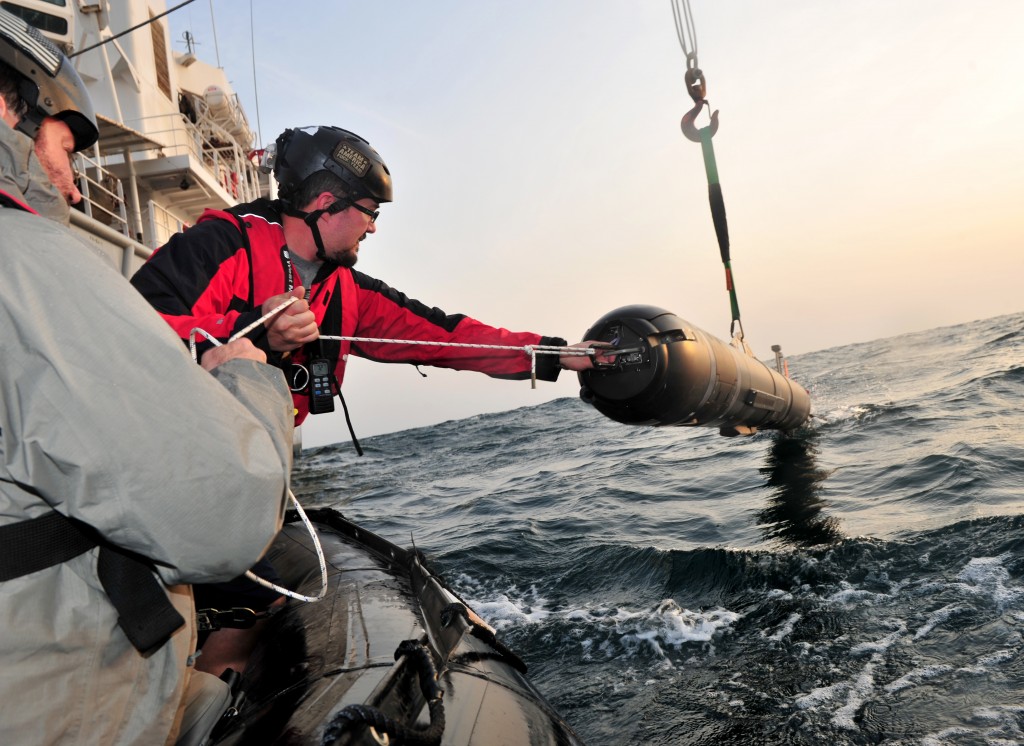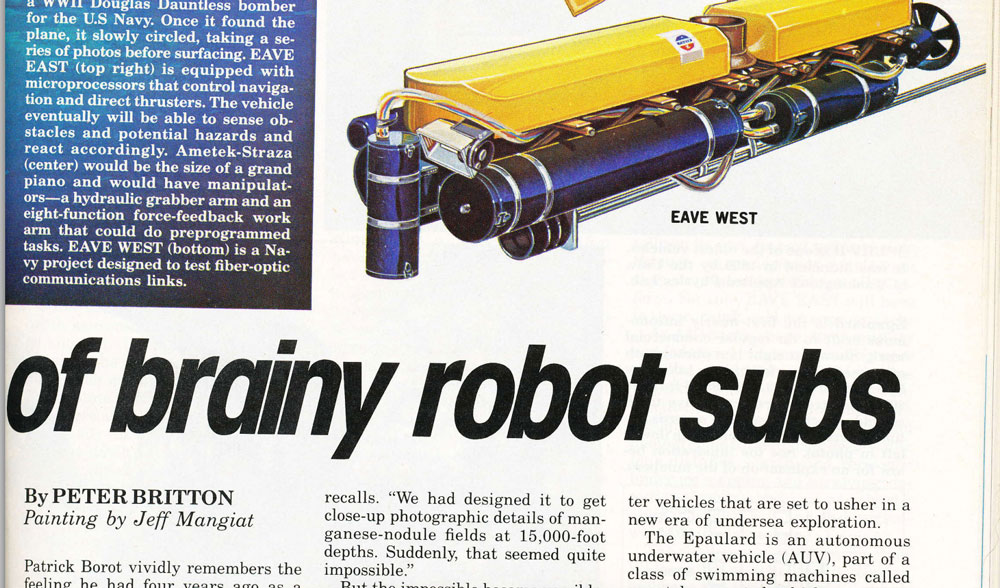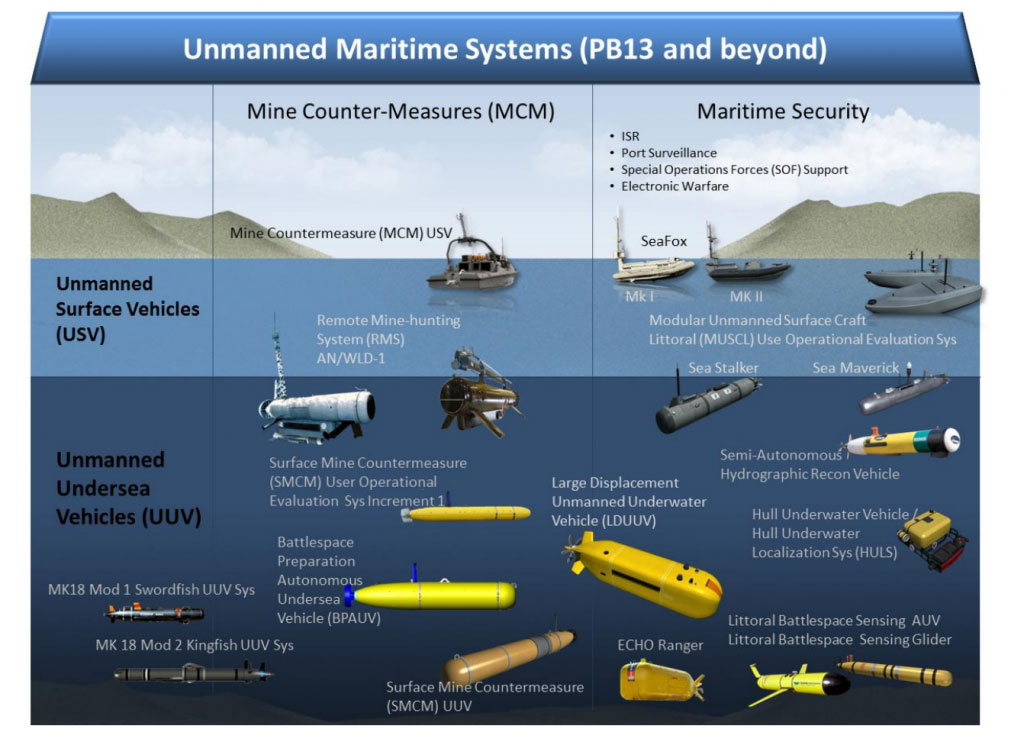
Robohub.org
What you need to know about underwater drones

A UUV is removed from the water during operations off the coast of Bahrain in 2013. Credit: Specialist 2nd Class Michael Scichilone/US Navy/Released
Late last month, Secretary of the Navy Ray Mabus appointed Brig. Gen. Frank Kelley to become the first deputy assistant secretary of the Navy for unmanned systems, a position that was created in April. “The change to the organization is a reflection of the priority we’re placing on this emerging capability,” Secretary Mabus said in a speech at the Unmanned Systems Defense 2015 conference on October 27. Kelley will be responsible for a variety of programs ranging from the high-flying Triton surveillance drone to experimental projects like the Navy’s fleet of swarming patrol boat drones. The new deputy secretary will also be overseeing drones that plumb the depths of the oceans. The development of torpedo-like submarine drones, also known as unmanned undersea vehicles (UUV) or autonomous undersea vehicles (AUV), is a major priority for the Navy. These drones, some of which could potentially remain submerged for months at a time, will serve in a variety of roles including surveillance and mine-hunting. At the Unmanned Systems Defense 2015 conference, Secretary Mabus said that the Navy is aiming to launch a squadron of autonomous UUVs by 2020 that can operate independently from manned vessels.
According to the Autonomous Undersea Vehicle Applications Center, a non-profit industry advocacy organization, there are 251 unique configurations of UUVs in service today, including 144 different vehicle platforms. That number is likely to grow in the coming years as the technology improves. Here’s what you need to know about UUVs:
Background
Submarine drones are generally classified either as remotely operated underwater vehicles (ROVs) or as UUVs. The former is a tethered vehicle that is piloted by crew members aboard a nearby vessel, while the latter is not tethered and is designed to operate largely independent of a human operator. In 1957, the University of Washington’s Applied Physics Laboratory developed the Special Purpose Underwater Research Vehicle, also known as SPURV. One of the first UUVs, the SPURV was funded by the Office of Naval Research and it could dive up to 10,000 feet and operate for four hours. By the time the SPURV program ended in 1979, other ROVs and UUVs were being developed in the United States, particularly for marine exploration and research. In 1985, the Argo, a remotely operated underwater vehicle, found the wreckage of the Titanic and, in 1989, the Bismarck, a World War II battleship. As a September 15 article in the New York Times pointed out, due to the lower operating costs and ability to stay underwater for extended periods of time, UUVs remain extremely attractive option for deep sea researchers.

A 1983 article in Popular Science detailing the use of UUVs for scientific exploration. Via AUVAC.
In the 1990’s, after two U.S. Navy ships were badly damaged by Iraqi sea mines in the Persian Gulf during Operation Desert Storm, the Navy began investing heavily in Mine Countermeasures and initiated a program to build UUVs that could disable enemy sea mines. The Navy’s 1994 Unmanned Undersea Vehicle (UUV) Plan set the priorities for the program; topping the list was the need to develop UUVs for organic and clandestine mine detection. In other words, the Navy needed a system that could avoid detection by operating underwater and in advance of dedicated minesweepers on the sea surface. In 1996, Northrop Grumman developed the Near-Term Mine Reconnaissance System, a two-vehicle platform that was designed to be launched from the torpedo tube of a submarine and connected to the vessel by a fiber-optic tether. The NMRS was replaced by the Long-Term Mine Reconnaissance System. The LMRS program produced the 20 ft.-long Boeing AN/BLQ-11 drone.
The UUVs of Today
In the years since the Navy’s foray into UUVs with the NMRS and LMRS, a number of underwater drones with varying capabilities have emerged. With the release of the Unmanned Undersea Vehicle Master Plan in 2004, the Navy set out nine priorities for future UUV capabilities that ranged from disabling enemy submarines to delivering supplies and launching weapons. Among the most prolific unmanned undersea drones are the REMUS family of UUVs. The Remote Environmental Monitoring UnitS program was initiated by Woods Hole Oceanographic Institution and Hydroid, a Massachusetts-based UUV manufacturer that is owned by Kongsberg Maritime. During Operation Iraqi Freedom in 2003, a REMUS UUV was used to help clear sea mines from the waterways around the port of Umm Qasr, marking the first time a UUV was deployed in a combat environment. One of the most capable Hydroid UUVs is the REMUS 600, a torpedo-shaped underwater drone designed to carry a large payload of sensors to great depths for meteorological and oceanographic surveying. The MK18 Mod 2 Kingfish, a variant of the REMUS 600, costs the Navy around $1.3 million apiece. Although the Marine Mammal Program, the Navy’s effort to use dolphins and sea lions to detect sea mines, is still running, it is expected that the Kingfish will replace the mammals within a few years.
 While the Navy has adopted an expansive view of what UUVs could possibly achieve, countering enemy mines remains a high priority. The Navy traditionally fields an array of air and sea systems to counter enemy mines, including fleets of minesweepers and low-flying helicopters that use sonar to detect mines. Instead of sending out human divers, UUVs can be used to disable the devices with a small explosive charge, eliminating the risk to sailors. UUVs are also fitted with sonar and other sensors that can autonomously map out minefields. The Battlespace Preparation Autonomous Vehicle, a Bluefin Robotics Bluefin-21, the Surface Mine Countermeasures, a General Dynamics Knifefish UUV, and the Remote Minehunting System, a Lockheed Martin Remote Multi-Mission Vehicle, all provide varying anti-mine capabilities. The Navy is under pressure to develop and deploy these systems, as existing platforms like the Avenger-class minesweeper and the Sea Dragon helicopters are quickly reaching the point for retirement. Instead of fielding specialized minesweepers, the Navy decided to couple mine countermeasures to existing manned vessels, including to the new Littoral Combat Ship (LCS), creating the MCM “module” for the LCS.
While the Navy has adopted an expansive view of what UUVs could possibly achieve, countering enemy mines remains a high priority. The Navy traditionally fields an array of air and sea systems to counter enemy mines, including fleets of minesweepers and low-flying helicopters that use sonar to detect mines. Instead of sending out human divers, UUVs can be used to disable the devices with a small explosive charge, eliminating the risk to sailors. UUVs are also fitted with sonar and other sensors that can autonomously map out minefields. The Battlespace Preparation Autonomous Vehicle, a Bluefin Robotics Bluefin-21, the Surface Mine Countermeasures, a General Dynamics Knifefish UUV, and the Remote Minehunting System, a Lockheed Martin Remote Multi-Mission Vehicle, all provide varying anti-mine capabilities. The Navy is under pressure to develop and deploy these systems, as existing platforms like the Avenger-class minesweeper and the Sea Dragon helicopters are quickly reaching the point for retirement. Instead of fielding specialized minesweepers, the Navy decided to couple mine countermeasures to existing manned vessels, including to the new Littoral Combat Ship (LCS), creating the MCM “module” for the LCS.
Funding for the UUVs is spread across several different procurement packages and research items. In Fiscal Year 2016, the Department of Defense is on track to spend around $232.9 million on UUVs, a $86.7 million increase over FY2015. However, this figure represents dedicated UUV spending, and does not necessarily include funds that are within larger spending packages. For example, while a large part of the Navy’s research into anti-submarine warfare surveillance, a $83.4 million project, will be spent on developing a UUV for detecting enemy submarines, the exact amount to be spent on this aspect of the program is unclear.
On the procurement and acquisition side, the Navy’s budget for Fiscal Year 2016 includes $51.7 million in funding for the Underwater Explosive Ordnance Disposal Programs, a fund that encompasses a large number of acquisition efforts for counter-mine technology, including the MK18 Mod 2 Kingfish. Another procurement line is the Remote Minehunting System, for which the Navy has allocated $87.6 million. The main product of the RMS is the Lockheed Martin’s Remote Multi-Mission Vehicle, an autonomous UUV that is intended to be deployed from a Navy ship to help search for mines by towing a sonar. The concept for the RMS was actually developed in the late 1990s, and it has had a checkered history. According to the latest Selected Acquisition Report for the RMS, the acquisition cost of a single system has doubled from $13 million to $27.7 million between 2007 and 2015. In September, Senators John McCain and Jack Reed criticized the Navy’s Remote Minehunting System program, arguing that the RMMV had failed to meet requirements and could be scrapped altogether. Last month, the Navy formed an independent board to review the RMS program.
“Put simply, while estimated overall spending on RMS is only a little higher than originally planned, it is only yielding half the number of systems, at more than double the unit cost, and it is taking twice as long to field it,” Sen. McCain wrote in a review of the RMS program. “Also, it doesn’t work.”
Military funds for UUV research and development are likewise scattered across a number of different programs. Two of the most well-defined research programs are the Knifefish Surface Mine Countermeasure Unmanned Undersea Vehicle—$17.4 million—and the Large Displacement Unmanned Undersea Vehicle—$38.8 million. Unlike UUVs intended specifically for countering mines, the LDUUV is designed to have multiple mission types including persistent intelligence gathering capabilities and payload delivery. When Secretary Mabus announced that the Navy is planning a squadron of autonomous underwater drones last month, these were platforms that he was referring to. According to Inside Defense, the Pentagon is expected to start soliciting bids from contractors to build the new systems within the next month or so. Yet, like the RMS program, the development of the LDUUV has not always been an easy sell on Capitol Hill. The Senate draft of the FY16 National Defense Authorization Act included comments that the planned LDUUVs are “too large and expensive to deploy in quantity but are likely too small to host the systems needed for long-endurance independent operations.” The final version of the FY16 subtracted $5 million in research funding for the LDUUV.
The Department of Defense has also allocated funding for more experimental UUV programs, sometimes within larger line items. For example, a portion of the $4 million allocated to the Chief of Naval Operations Rapid Innovation Cell will go towards Project NEMO, which is developing biomimetic UUVs that can swim like a fish. The Defense Advanced Research Project Agency has allocated $32.7 million towards Hydra, a project to develop a network of unmanned underwater assets that could be deployed quickly to respond to emerging threats. Like the Hydra project, the goal of DARPA’s Upward Falling Payloads initiative, to which it has allocated $22 million, is to design affordable unmanned systems that are deployed to multiple locations and that, when remotely activated, can rise to the surface to deliver either a waterborne or airborne payload of explosives or supplies. Distributed Agile Submarine Hunting, another DARPA project to which $8.5 million is allocated, includes the development of UUV that tracks submarines.
Conclusion
Compared to unmanned vehicles in the air and on the ground, maritime drones are less well known. The impending retirement of manned vessels like minesweepers and recent geopolitical events indicate that that could change within the next few years. In the race to develop unmanned systems, other countries are pursuing UUV programs. In 2014, the Yomiuri Shimbun reported that Japan and the U.S. were collaborating on a 33-ft.-long UUV that would be used to help patrol areas using sonar along a pre-programmed route. A RAND report on Chinese drones that released earlier this year found that Beijing is funding at least 15 different university research programs into unmanned undersea and surface vehicles with particular emphasis on UUV projects. A Russian news broadcast last week unintentionally confirmed suspicions that Russia was building a long-range UUV capable of carrying a nuclear warhead.
Unmanned submersibles could provide decisionmakers with a low-cost alternative to manned platforms for missions like minesweeping that are particularly dangerous or for mission that are tedious, like patrolling. UUVs, particularly those envisioned by DARPA, could also be a way to assert military presence in an area that is difficult to reach or geopolitically contentious. Like the minesweeper concepts, UUV platforms could be built into the capabilities of existing manned platforms like the Littoral Combat Ship or submarines. Alternatively, larger UUVs may be deployed from ports and conduct missions independent from manned ships.
The development of ingenious new unmanned systems like Boeing’s hybrid UUV and UAV Rapid Deployment Air and Water Vehicle shows that the technology is progressing quickly. However, as a thorough 2009 RAND study of UUV systems pointed out, some of the Navy’s proposed UUV missions were not practicable and remained out of reach. Issues with reliability, specifically within the realms of underwater communications and propulsion, suggests that the technology has yet to mature. The controversy over the Remote Minehunting System is one example of how the Navy has struggled to develop an adequate countermine alternative to minesweepers. While UUVs present significant advantages in terms of cost and safety over manned platforms, it will be some years before UUVs are accepted into the fleet.
This post originally appeared on the Center for the Study of the Drone at Bard College.
If you liked this article, you may also be interested in:
- Autonomous underwater system for monitoring health of Venice Lagoon demos at #EXPO2015
- CoCoRo: Tracking the development of the world’s largest autonomous underwater swarm
- Ocean-going robot fleet successfully completes fish-tracking mission
- British National Oceanographic Centre launches major unmanned exploration mission
- ROV operations expenditures to grow to $1.5 billion by 2017
See all the latest robotics news on Robohub, or sign up for our weekly newsletter.
tags: AUV, c-Military-Defense, cx-Exploration-Mining, Drone, underwater, UUV




